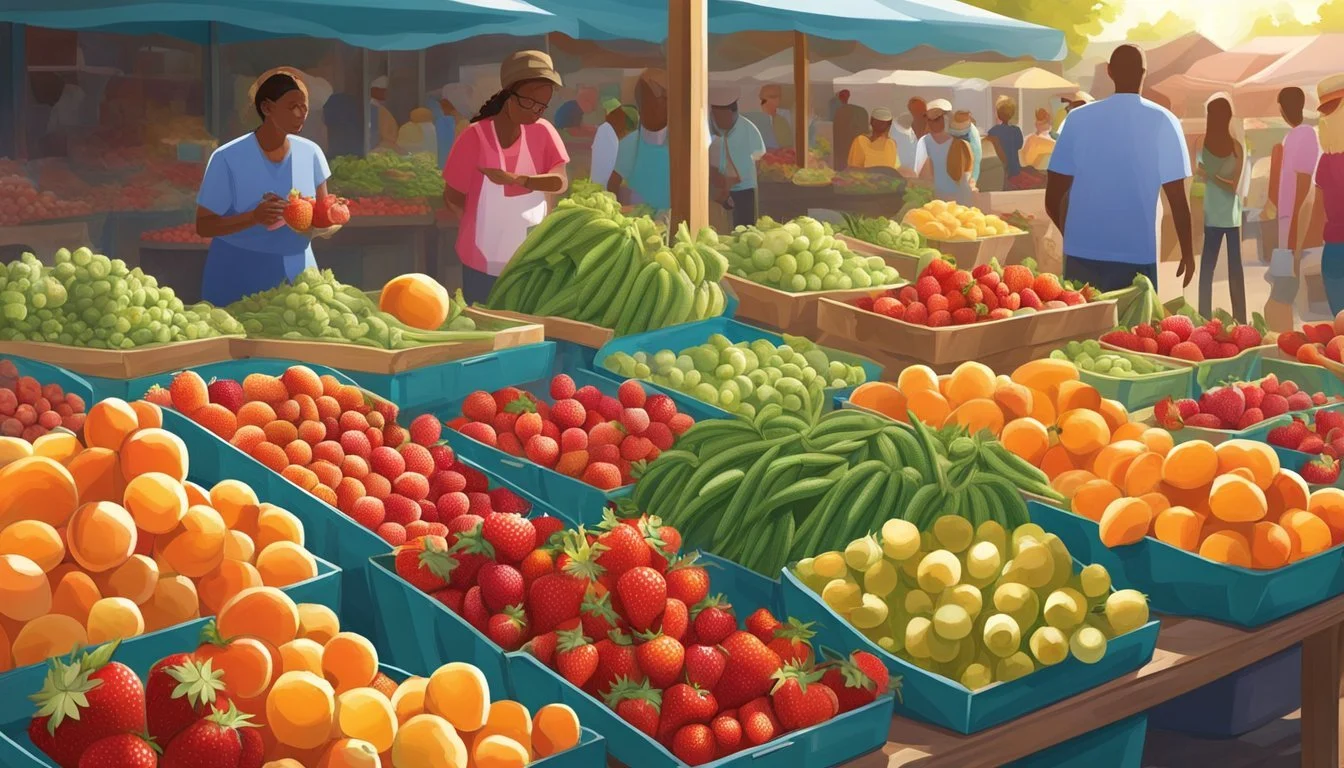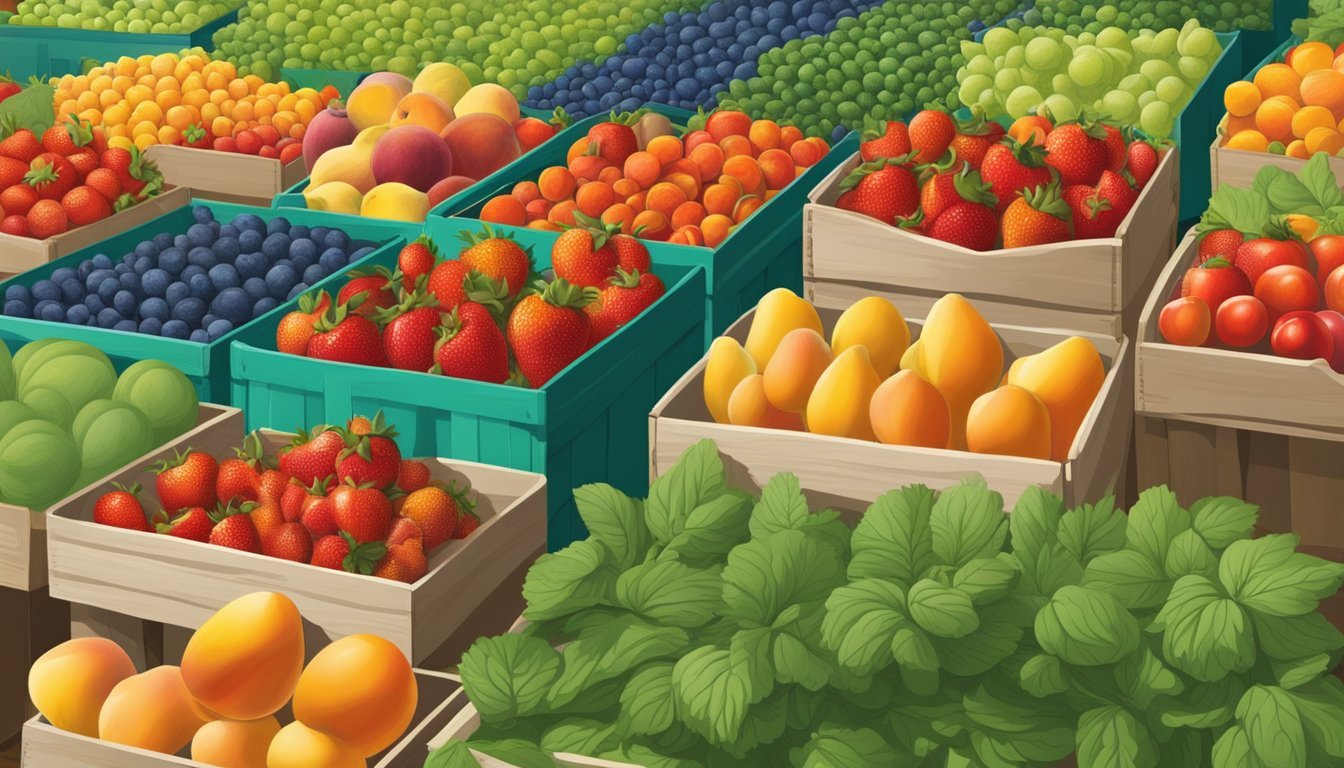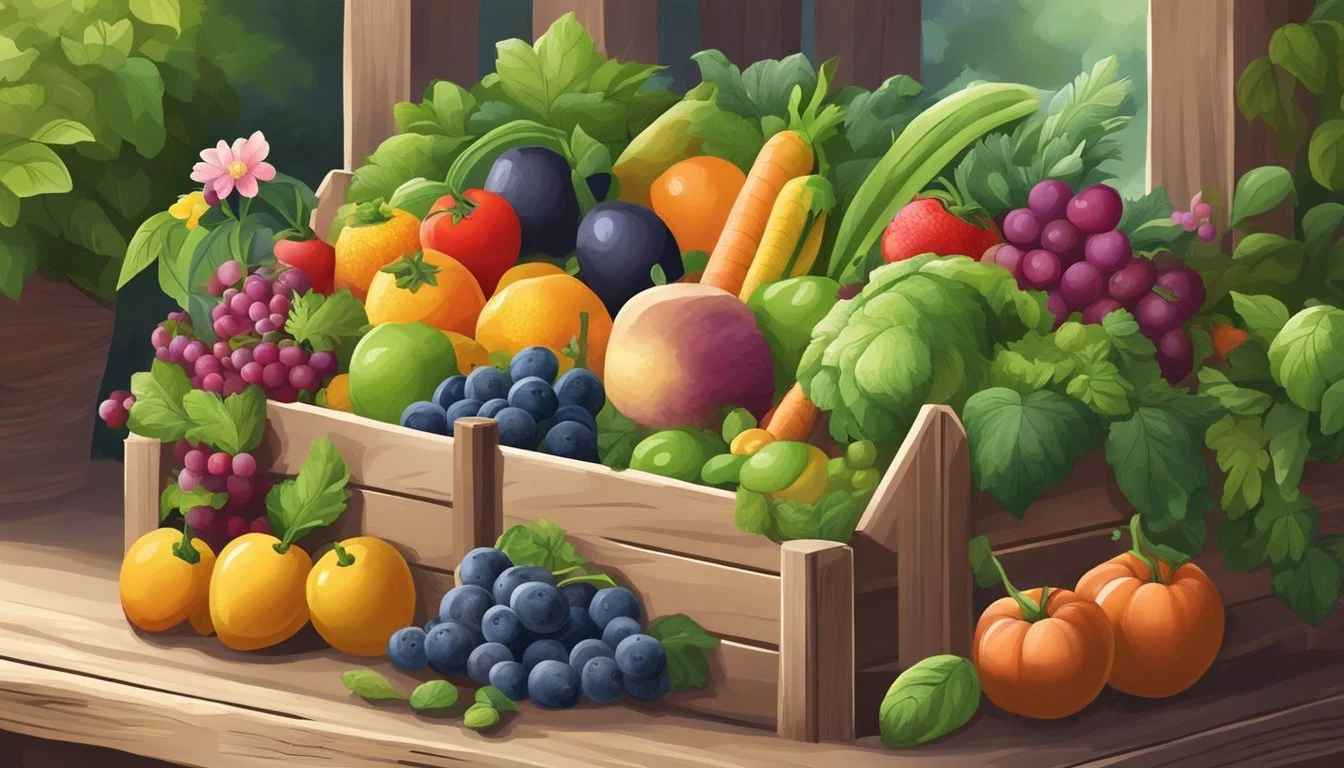Alabama Seasonal Fruit & Vegetables in May
Your Fresh Produce Guide
This Article is Part of our Alabama Seasonal Fruit & Veg Calendar
In Alabama, May is a prime time for an abundance of fresh produce. As spring progresses towards summer, gardens and farms throughout the state begin to offer a variety of fruits and vegetables at local markets. The mild climate of the region allows for an excellent growing season, and consumers can enjoy a wide range of flavors as new crops reach their peak.
Seasonal fruits that typically become available in May include strawberries, blueberries (how long do blueberries last?), and peaches, making it an ideal month for those looking to incorporate fresh, juicy flavors into their diet. Meanwhile, vegetables such as cucumbers (how long do cucumbers last?), snap beans, and sweet corn also start to appear, offering a fresh palette of taste and nutrition for wholesome meals.
Local farms and gardens capitalize on the favorable conditions to harvest produce that is ripe and full of flavor. This abundance is not only a boon for the taste buds but also supports a healthy lifestyle with nutrient-packed options. Consumers have the opportunity to savor the seasonal offerings that are characteristic of Alabama’s rich agricultural landscape.
Understanding Alabama's Unique Climate
Alabama's climate significantly influences its agricultural calendar, affecting the growth and harvest times of various fruits and vegetables. The state's location in the southeastern United States exposes it to a warm climate, with hot summers often playing a pivotal role in the ripening of produce.
The state diversely spans USDA hardiness zones 6b to 9a, accounting for varying regional climate conditions. This range indicates that while the northern parts tend to experience cooler temperatures, which can lead to occasional frost, the southern regions maintain a milder climate conducive to a longer growing season.
Hardiness Zone Average Minimum Temperature Range 6b -5 to 0°F 7a 0 to 5°F 7b 5 to 10°F 8a 10 to 15°F 8b 15 to 20°F 9a 20 to 25°F
Proper soil management is crucial in Alabama's varied climate. Farmers ensure their soils have adequate nutrients and moisture retention to support crop needs, especially during the heat. With hot temperatures in the growing season, additional irrigation can be necessary to sustain ideal soil conditions.
Understanding the local climate, specifically hardiness zones and seasonal temperatures, assists in predicting the ideal planting and harvesting periods for Alabama's seasonal fruits and vegetables. This foresight enables farmers and gardeners to optimize their yields and provides consumers with the freshest local produce available.
The Seasonality of Produce
May in Alabama heralds a bounty of fresh produce, marking a period where the spring harvests blend into early summer varieties. Consumers have the advantage of accessing a diverse range of fruitful options that are at their peak in terms of flavor and nutritional value. The produce calendar indicates that this is a prime time for a variety of fruits and vegetables.
Fruits available during this time exhibit vibrant flavors, comprising of:
Strawberries
Blueberries
Peaches
These fruits are not only succulent but also rich in essential vitamins, making them ideal for fresh consumption or in culinary preparations.
As for vegetables, the selection includes both leafy greens and root vegetables:
Tomatoes
Sweet Corn
Cucumbers
Squash
Snap Beans
Okra
These vegetables offer a combination of textures and tastes that complement any dish. They are perfect for those seeking ingredients for a fresh salad or for cooking up something more substantial.
A seasonal produce guide assists shoppers in identifying the freshest local produce. The guide typically emphasizes consuming produce within its natural harvest season, thereby ensuring maximal taste and nutrition. It additionally supports the local economy and reduces the environmental impact of long-distance food transport.
In conclusion, May is a month where one can expect an abundance of fresh produce in Alabama, with options suitable for any palate and culinary need. It is advised to take advantage of the season's offerings for the freshest experience.
What's in Season?
In May, Alabama's warm climate brings a bounty of fresh produce to the local markets. Consumers can find a variety of both organic and traditionally cultivated vegetables and fruits, which are perfect for those looking to indulge in seasonal freshness.
Fresh Vegetables
May sees an upsurge in the availability of vegetables in Alabama. Shoppers can expect:
Beans: A selection of beans becomes readily available, with snap beans being particularly tender.
Corn: Fresh, sweet corn is hitting its stride, offering a sweet and crisp option.
Tomatoes: Vine-ripened tomatoes burst onto the scene, ripe for salads and sandwiches.
Cucumbers and Lettuce: Essential for cool salads, cucumbers and a variety of lettuces thrive in the temperate weather.
Spinach: Lush green spinach leaves are perfect for a nutrient-rich addition to any meal.
Onions: The harvest of sweet and pungent onions begins, adding flavor to an array of dishes.
Carrots and Potatoes: Root vegetables like carrots and potatoes are being dug up, full of earthy flavors.
Peas: Both green peas and southern black-eyed peas (how long do black-eyed peas last?) are tender and sweet during this month.
Ripe Fruits
Fruit lovers will rejoice at the assortment of fruits that May brings to Alabama's local produce stands:
Watermelon and Melons: These begin to signal the start of hot weather refreshments.
Peaches: Juicy peaches typically start to appear and are a sign of the approaching summer bounty.
Strawberries: May offers the last call for strawberries, as their season winds down.
Berries: Blueberries and blackberries start to come into season, ready to be enjoyed in desserts or as a healthy snack.
Fruits not commonly harvested in May in Alabama, such as apples, should be considered out of their prime local season.
Planting and Harvesting Tips
In May, Alabama gardeners should focus on planting heat-loving vegetables and preparing for the summer harvest. Timing and technique are crucial for a bountiful garden.
Best Planting Practices
Gardeners in Alabama should plant seeds of summer crops like okra, southern peas, and eggplant in early May. These warm-weather plants thrive when the threat of frost has passed and the soil has warmed. For a more extended harvesting season, consider planting squash and cucumbers in succession, spacing out plantings every two weeks.
For fall crops such as broccoli, cabbage, and cauliflower, gardeners should start seeds indoors or in a protected area to transplant into the garden later in the season. The seedlings for these vegetables are generally ready to be moved to the garden in late July to early August.
Seeds to Plant:
Okra
Southern peas
Eggplant
Transplants to Ready:
Broccoli
Cabbage
Cauliflower
Optimal Harvesting Periods
May is also the time for harvesting the last of the cool-season crops before the heat of the summer sets in. Vegetables like leafy greens and some root vegetables should be harvested now if they are not already bolted.
For summer crops, it is essential to harvest regularly to encourage continuous production throughout the season. Certain vegetables like squash and okra should be picked when they are young and tender, which also prevents them from becoming too large and tough.
Vegetables to Harvest:
Leafy greens
Root vegetables (if still available)
Young squash and okra
By adhering to proper planting calendars and utilizing efficient gardening practices, growers can maximize their yield and enjoy fresh produce throughout the impending summer and into the fall.
Health Benefits of Seasonal Eating
Eating seasonal fruits and vegetables provides numerous health benefits. Seasonal produce tends to be fresher and is often harvested at its peak ripeness, which means it can offer a better taste and higher nutritional value. When fruits and vegetables are picked during their natural growing season, they have had the optimal time to develop an abundance of vitamins and minerals.
Freshness also plays a crucial role in the fiber content of produce. Fresh, seasonal fruits and vegetables typically retain more fiber compared to their out-of-season counterparts, which are often picked before ripening and transported over long distances. A diet rich in fiber is essential for maintaining a healthy digestive system and can aid in preventing various health conditions.
Here's a quick breakdown of specific benefits:
Vitamins: Essential for immune system function and overall health.
Minerals: Crucial for bone health, energy production, and many other bodily functions.
Fiber: Supports digestive health and can help in managing blood sugar levels.
Consumers who opt for seasonal and local produce may also find a broader range of organic options. Organic fruits and vegetables are grown without synthetic pesticides or fertilizers, which could lead to a reduced intake of potentially harmful chemicals.
Lastly, the practice of eating seasonally aligns with supporting local farming communities. It encourages purchasing from nearby growers, which not only bolsters the local economy but also reduces the environmental impact due to shorter transportation distances. By choosing seasonal fruits and vegetables, such as those available in Alabama during May, individuals not only nourish their bodies with wholesome nutrition but also contribute to a more sustainable food system.
Preparing and Storing Produce
In May, Alabama's bounty includes fresh produce like lettuce, sweet potatoes (What wine goes well with sweet potatoes?), green beans, and an array of herbs and berries, each with its best methods for preservation to retain taste and nutrition. Ensuring these fruits and vegetables last while maintaining their flavor profiles is key in the preparation and storage process.
Recipe Ideas
Lettuce forms the base for numerous salads and can be used in wraps and sandwiches. For a twist on traditional uses, consider wilting lettuce in soups or incorporating it into smoothies for added nutrition.
Sweet Potatoes are versatile and can be used in both savory and sweet recipes. They can be roasted, mashed for a comforting dish, or sliced and baked as chips. They also make for a flavorful addition to stews.
Green Beans shine in dishes whether they are steamed, sautéd, or roasted. Combine them with garlic to create a fragrant side or toss them in a vibrant salsa.
Incorporating Herbs like basil or oregano into sauces enhances the taste of any dish.
Storage Solutions
When it comes to storage, each produce item has its own requirements:
Lettuce should be rinsed, dried thoroughly, and stored in a refrigerator within a loose plastic bag or a container lined with paper towels to maintain crispness.
Sweet potatoes prefer a cool, dark place, ideally separate from other produce to prevent accelerated spoilage.
Cranberries are best kept in a sealed container in the refrigerator but can also be frozen to extend their shelf life.
Keep Celery (how long does celery last?) crisp by wrapping it in aluminum foil and refrigerating it, which allows ethylene gas to escape and prevents wilting.
For preserving Garlic, store it in a cool, dry place with good air circulation to prevent it from sprouting.
Produce Storage Method Location Expected Shelf Life Lettuce Rinsed, dried, and bagged/container Refrigerator 5-7 days Sweet Potatoes In a cool, dark place Pantry 3-5 weeks Green Beans Unwashed, in plastic bag Refrigerator 7 days Cranberries Sealed container Refrigerator/Freezer 2 months/1 year Celery Wrapped in aluminum foil Refrigerator 2-4 weeks Garlic In a ventilated container Pantry 3-5 months
By following these recipe suggestions and storage solutions, you'll make the most out of Alabama's May produce, enjoying the fresh flavors long after harvest.
Supporting Local Agriculture
May marks the beginning of a lush period for local agriculture in Alabama, with an abundance of seasonal fruits and vegetables ripe for the picking. Consumers can directly support this vital sector by visiting farmer's markets and purchasing from local vendors. This not only sustains the regional economy but also reduces the carbon footprint associated with long-distance transportation.
Choosing local produce at grocery stores is another effective way of backing Alabama's farmers. Many stores highlight local sections, making it easier for customers to make region-supporting choices. This choice ensures that the fruits and vegetables are fresher, having traveled far fewer miles from farm to shelf.
Social media platforms have emerged as powerful tools in promoting local agriculture. They provide farmers with the means to share updates, harvest calendars, and market events, thus enhancing their visibility within the community.
Local agriculture largely flourishes on the principle of seasonality. Consumers are encouraged to explore local offerings such as:
Sweet potatoes
Strawberries
Lettuce varieties
Kale
Spinach
By supporting local farms, individuals are participating in a sustainable food system that benefits both the environment and the economy of the region at large. Embracing local produce not only fosters community but ensures that Alabama's agricultural heritage continues to thrive.
Navigating Markets and Food Systems
In Alabama, individuals looking for fresh seasonal fruits and vegetables in May have a variety of options through different food systems. Grocery stores typically have a broad selection but may not feature the local harvests prominently. Consumers can identify whether produce is locally sourced by checking labels or inquiring with store staff.
Farmer's markets, on the other hand, provide direct access to locally grown produce. Buyers can expect to find an assortment of Alabama’s seasonal offerings here. These markets support local food systems and economies, connecting consumers directly with farmers. Below is a table highlighting typical May produce to look out for:
Fruits Vegetables Strawberries Sweet corn Blueberries Tomatoes Peaches Zucchini Cucumbers Bell peppers Snap beans
Transportation to and from markets is key in accessing these fresh options. Locations of farmer’s markets are often in central areas, accessible by public transportation or community transit services, which is an important aspect of a sustainable food system.
It's vital to consider the food systems at play. Farmers often depend on these direct-to-consumer models for sustainability, while consumers gain from the freshest picks of the season. Understanding when and where to shop can enhance the overall shopping experience and contribute positively to Alabama's agricultural landscape.
Conclusion
In Alabama, the month of May marks a vivid transition into a season of abundance for fruit and vegetable enthusiasts. Markets come to life with a variety of locally grown produce, reflecting the state's agricultural prowess.
Fruits ripe for the picking include:
Strawberries
Blueberries
Vegetables entering their peak season comprise:
Spinach
Lettuces (butter, leaf, romaine)
Mustard greens
Kale
These items not only add a burst of flavor and color to meals but also offer nutritional benefits that are essential for maintaining good health. Consumers can enjoy these fresh products, knowing that they are indulging in some of the freshest, most nutritious offerings available.
Alabama’s local farmers work diligently to ensure the fruits and vegetables are harvested at their peak to offer both superior taste and nutritional value. By choosing to purchase seasonal produce, individuals support local agriculture and contribute to a more sustainable food system.
May presents an ideal opportunity for residents and visitors alike to explore the rich tapestry of Alabama's horticultural offerings. Whether incorporated into recipes or enjoyed on their own, these seasonal fruits and vegetables are a testament to the state's fertile lands and the dedication of its farmers.










